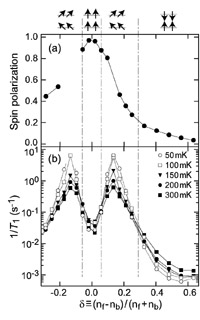1Physical Science Laboratory, 2Tohoku University
Two-dimensional electron system (2DES) formed in a high-mobility semiconductor
heterostructures can be an ideal laboratory to study many-body phenomena
in low dimensions. In a quantum Hall (QH) system, which appears by applying
magnetic field perpendicular to a 2DES, the kinetic energy of electrons
is quantized into Landau levels and electron-electron interactions completely
dominate physics. In particular, in a bilayer system consisting of closely
separated 2DESs, interplay between the spin and layer degrees of freedom
leads to various broken symmetry states called QH magnets. We developed
nuclear magnetic resonance (NMR) techniques for QH systems and studied
static and dynamic properties of electron spin in QH magnets [1-3].
NMR is commonly used as a powerful probe of spin states in various
electronic systems. For QH systems, however, a small number of nuclei in
contact with the 2DES have restricted NMR measurements to multiple-layer
samples. To perform NMR in a bilayer QH system, we exploit current-induced
nuclear spin polarization and its resistive detection. The Knight shift
of the NMR spectrum, which is proportional to the electron spin polarization,
shows the existence of the canted antiferromagnetic state between the ferromagnetic
and spin-singlet states with full and null spin polarizations, respectively
(Fig. (a)). Furthermore, the nuclear spin relaxation rate reveals that,
in the canted antiferromagnetic state, low-frequency electron spin fluctuations
do not freeze out even in the low-temperature limit (Fig. (b)). The collective
fluctuation at low temperature is characteristic behavior of broken symmetry
states in two dimensions.
[1] N. Kumada, et al., Phys. Rev. Lett. 94 (2005) 096802.
[2] N. Kumada, K. Muraki, and Y. Hirayama,Science 313 (2006) 329.
[3] N. Kumada, K. Muraki, and Y. Hirayama, Phys. Rev. Lett. 99 (2007) 076805.
 |
||
|